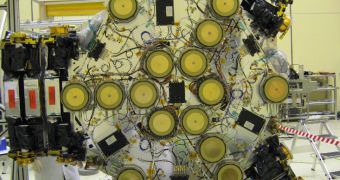On November 2, 2009, the European Space Agency (ESA) launched two new spacecraft in Earth's orbit, aboard a Russian-built Rockot delivery system. The largest payload was the large Soil Moisture and Ocean Salinity (SMOS) satellite, which was accompanied by the small demonstrations spacecraft Proba-2. Both probes have one thing in common, and namely the use of fiber optics, a technology that, while used extensively for telecommunications on Earth, is still very new in space. ESA officials say that, in fact, the very success of these missions depends on the how the fiber optics systems are handled.
The first European mission-critical use of fiber optics is on SMOS, a satellite that has a tremendous resolve power, but which will be heavily reliant on the technology throughout its operational life. The machine has not yet begun the science phase of its flight, but preliminary commissioning tests show that all systems are fully operational. The satellite will be in charge of picking up faint, naturally-emitted radio signals emanating from the planet, which will then be used to track ocean salinity and soil moisture. The datasets obtained in this manner will then be used to study climate change and weather patterns.
On the other hand, the Proba-2 micro-satellite is aimed at the Sun, in a bid to keep an eye on space weather. The instrument is less than one cubic meter in volume, and is meant to be a technology demonstrator for future, larger missions. The spacecraft's propulsion system is being monitored using a fiber-optic sensor system, ESA officials announce. The system is similar to the one employed on SMOS. Its triple-armed MIRAS (Microwave Imaging Radiometer using Aperture Synthesis) instrument depends on this technology for communicating with Mission Control.
“SMOS is the first mission worldwide whose payload depends critically on the performance of optical fiber links. This represents a historical turning point for the use of lightwave technologies in space – there are more than 500 meters of optical fibers embedded within the MIRAS instrument. By comparison, Proba-2 has a mere six optical fiber lines, but they are being used in a whole new way, to make temperature and pressure measurements around its fuel tank, propellant lines and thruster nozzle,” explains ESA Directorate of Technical and Quality Management (TEC) opto-electronic engineer Dr Nikos Karafolas.
“MIRAS is basically a receiver, detecting very faint thermal noise from Earth’s surface, which has to be amplified ten billion-fold before it is used. Any electrical noise leaking out from the electronic boxes in the arms can influence the correlation measured and blur the resulting images. However, optical fibers relay information with light pulses rather than electrical signals, so they do not produce any electromagnetic radiation,” adds ESA SMOS payload engineer Manuel Martin-Neira.

 14 DAY TRIAL //
14 DAY TRIAL //